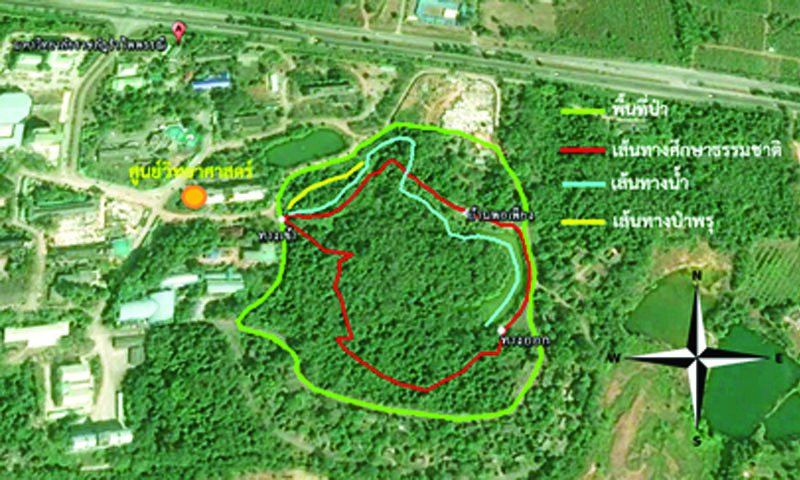Survey of Lichen at Swamp Forest in Plant Genetic Protection Area, Rambhai Barni Rajabhat University
Main Article Content
Abstract
Lichen at swamp forest in Plant Genetic Conservation Project under the Royal Initiative of Her Royal Highness Maha Chakri Sirindhorn, Rambhai Barni Rajabhat University were surveyed in January - October 2018. The lichens were collected on both sides of the nature trail of swamp forest (about 220 meters), together with environmental data collection. Total of 53 samples were examined the morphology, taxonomy and chemical composition by spot test in laboratory. The predominance of taxa belonging to the crustose lichen (96.23 %) and only 2 samples were foliose lichen (3.77 %). The lichen samples were identified into 10 family, 16 genus and 27 species. The third largest family of lichen were Graphidaceae (7 genus, 11 species and non-identify 1 species, 26 samples), followed by Pyrenulaceae (1 genus, 3 species and non-identify 1 species, 8 samples) and Malmideaceae (1 genus, 1 species and non-identify 1 species, 6 samples), representing 49.06, 15.09 and 11.32, respectively. In which, these three lichens are usually grow in humid and shady environments.
Article Details
References
[2] Ahmadjian, V. and Hale, M. E. (1993). The Lichens. Academic Press. New York
[3] Gilbert, O. (2000). Lichens. London. HarperCollins
[4] Somnuek, C., Poengsungnoen, V., KhamChatra, N., and Nongnutch, K. (2017). Lichens on Nature Trail in Plant Genetic Conservation Project, Rambhai Barni Rajabhat University, Chanthaburi Province. KKU Science Journal. Vol. 45, No. 1, pp. 193-199 (in Thai)
[5] Upreti, D. K. (1998). Diversity of Lichen in India. In: Perspective in Environment (Eds.: S. K. Aggarwal; J. P. Kaushik; K. K. Kaul and A. K. Jain), New Delhi, A.P.H. Publishing Corporation. pp. 71-79
[6] Tiwari, S. C. and Prajapati, A. (2015). Lichen as Indicator of Forest Health Status in Achanakmar Amarkantak Biosphere Reserve. International Journal of Research Studies in Biosciences (IJRSB). Vol. 3, Issue 4, (April 2015). pp. 70-79
[7] Sodamuk, M. and Mongkolsuk, P. (2014). Lichen in Mangrave Forest at Koh Rua Sri, Trat Province in the Eastern, Thailand. In Proceeding of the 40th Congress on Science and Technology of Thailand (STT40). pp. 826-830
[8] Boonpragob, K. and Buaruang, K. (2007). Lichen of Samaesan Island from hilltop to the Sea. Bangkok: Ramkhamhaeng University Press. (in Thai)
[9] Saipunkaew, W. (2008). Lichen and Environmental Quality Inspection. Workshop Document. Department of Biology, Faculty of Science, Changmai University. Changmai. (in Thai)
[10] Zedda, L. (2009). Report on Lichen Sensitivity to Air Pollution with Special Reference to Sulphur Dioxide (SO2). Access (5 February 2019). Available (https://www.researchgate.net/publication/242270865)
[11] Lücking, R., Plata, E. R., Parnmen, S., Kalb, K., Mangold, A., and Lumbsch, H. T. (2011). Tropical Lichen Guides: Graphidaceae Lichens of the World. Access (11 February 2019). Available (https://fieldguides.fieldmuseum.org/ guides/guide/355)
[12] Lange, O. T., Green, T. G. A., and Heber, U. (2001). Hydration-Dependent Photosynthetic Production of Lichen: What Do Laboratory Studies Tell us About Field Performance?. Journal of Experimental Botany. Vol. 52, Issue 363, pp. 2033-2042. DOI: 10.1093/jexbot/52.363.2033
[13] Phokaeo, S., Polyiam, W., Buaruang, K., Vongshewarat, K., and Boonpragob, K. (2013). Preliminary Study on the Pyrenolichens from the Islands of Thailand. Thai Journal of Botany. Vol. 5, (Special Issue). pp. 62-73 (in Thai)
[14] Sriprang, V. and Mongkolsuk, P. (2010). Discolichens at Phu Luang Wildlife Sanctuary, Loei province. Thai Journal of Botany. Vol. 2, (Special Issue). pp. 47-53 (in Thai)
[15] Saipunkaew, W., Wolseley, P., and Chimonides, P. J. (2005). Epiphytic Lichens as Indicators of Environmental Health in the Vicinity of Chiang Mai City, Thailand. Lichenologist. Vol. 37, No. 4, pp. 345-365

